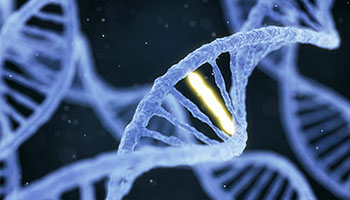HOW CAN WE HELP YOU? Call 1-800-TRY-CHOP
In This Section
What is PU.MA, a New Disease Discovered by CHOP Scientists?

PU.1 Mutated Agammaglobulinemia, an inherited immunodeficiency disease, is caused by an SPI1 mutation.
The findings:
Researchers at Children’s Hospital of Philadelphia described a new immunodeficiency disease, which they named PU.1 Mutated Agammaglobulinemia (PU.MA), that prevents the formation of infection-fighting B cells and antibodies. With the help of study participants from CHOP and around the world, the team pinpointed the genetic mutation SPI1 responsible for this condition and validated its role in diseased B cell development in vitro.
Why it matters:
Patients such as CHOP study participant Luke Terrio and their families often traverse a frustrating diagnostic odyssey of strange symptoms and misdiagnoses before arriving at a cause for their condition. Now, by describing PU.MA at a molecular level, researchers have the ability to not just provide answers for these families, but also help direct the most appropriate therapies. Furthermore, the discovery opens the door for scientists to learn more about how PU.1 might play a role in other diseases and conditions.
Who conducted the study:
The paper’s senior author, Neil Romberg, MD, investigator in the Department of Pediatrics, and first author, Carole Le Coz, PhD, conducted the study with numerous CHOP departments, including the Roberts Individualized Medical Genetics Center, the Center for Spatial and Functional Genomics, and the Cancer Center, as well as with institutions around the world. (For a full list, see the study below.)
How they did it:
After comparing whole exome sequences from 30 patients born without B lymphocytes, the team identified six patients with a heterozygous mutation in the SPI1 gene, which encodes the PU.1 protein. With less PU.1, B cells were not able to form. Thus, though the six PU.MA patients each had different SPI1 mutations, they all shared insufficient levels of PU.1, absent B cells, and no antibodies. The team then used a novel CRISPR screen to validate the roles of SPI1 and PU.1, reconstituting the patient’s diseased B-cell development in vitro, and they found that B cells were specifically intolerant of PU.1 decrements.
Quick thoughts:
“Identifying rare genetic variants in patients is now faster, cheaper, and more readily available using next-generation sequencing,” Dr. Romberg said. “Proving variant causality still requires multiple orthagonal scientific approaches and big collaborative teams that ideally include patients/patient families.”
What’s next:
The team identified patients with different PU.1 mutations, according to Dr. Romberg. Though these patients are able to make B cells, they have a surplus of autoantibodies — offering an opportunity to describe diseases caused by PU.1 mutations that give more of an autoimmune phenotype rather than an immune deficient phenotype.
“We think just like PU.MA taught us all about B-cell development, these patients can teach us a lot about more common disorders including autoimmune diseases and cancer,” Dr. Romberg said.
Where the study was published:
The study appeared in the Journal of Experimental Medicine.
Where to learn more:
Read more about Luke Terrio, one of the study’s participants.


